-
December 22, 2009 - NEW
I have added several additional works by Daniel Chester French to my online gallery of images of his sculpture,
Daniel Chester French: Sculpture in Situ.
Newly added are French's "Head of Victory" (First Division Memorial), "Thomas Starr King," "Wendell Phillips, " and "James Hooker." I have also added new photos and commentary of three
of French's other works, "Mourning Victory," "The Angel of Death and the Sculptor" and "Memory." These additions make a total of 30 of French's scuptures that appear in this ongoing and
growing resource.
-
December 16, 2009 - COMMENTARY
As I mentioned in my
sabbatical diary entry for May 14, 2009 I am in my 25th season as bass trombonist of the Boston Symphony Orchestra which, by extension,
means this is my 25th season with the
Boston Pops Orchestra as well. At this time of year, we are deep into our annual schedule of "Holiday Pops" concerts,
and this time of year brings back many memories of past years of such concerts. There have been changes to be sure but at their heart, these concerts bring a lot of enjoyment to
thousands of people each year. This season, the Pops has commissioned a special telling of the Christmas story with narration from Scripture, a vocal solist and chorus that has special
meaning for me and many in our audiences.
My daughter, Robin, recently sent me a link to a YouTube video that was filmed during my first season in Boston, 1985. It shows John Williams leading the Boston Pops Orchestra in Leroy Anderson's
classic, "Sleigh Ride." Watching this video brought back so many memories of colleages now long gone, and of a time when the pace of concerts was more relaxed.
Perhaps you, too, might enjoy this trip down memory lane. For those interested, the brass section
includes: Norman Bolter, Larry Isaacson, myself (trombones), Chester Schmitz (tuba), Charles Daval, Peter Chapman, Andre Come, Bruce Hall (trumpets), and Richard Sebring, Daniel Katzen,
Jonathan Menkis and Richard Mackey (horn). Click on the image below and enjoy it yourself. Merry Christmas!
-
December 11, 2009 - NEW
I have added a new section to my website,
Resources for young players. My oldest daughter, Linda, is a private low brass instructor in the Chicago area. Over the years,
she has developed a number of resources to help her students; with a studio that has as many as 40 students taking lessons each week, she has a broad experience with young players
from elementary through high school. I thought Linda's resources might be helpful to others, so together we have developed a new area on my website devoted to resources for young players.
Included are many of Linda's handouts and masterclass summaries along with links to other resources for young players that already appear on my website and on external sites. Linda has
also put together some resources for teachers of young players that might be helpful to those who have or are considering starting a teaching studio. I am very proud of Linda and her
work with her students - many of whom place well in Illinois school auditions and go on to be music majors in colleges and universities - and am happy to have her resources in this
new are on my website.
-
October 30, 2009 - COMMENTARY
 Last week, I attended the 30th Symposium on Musical Instrument Making: The Cornett - History, Instruments and Construction, held at Kloster Michaelstein, Germany. This Symposium
offered me a time of tremendous satisfaction as I continue to explore early music - in particular my interest in the serpent.
Last week, I attended the 30th Symposium on Musical Instrument Making: The Cornett - History, Instruments and Construction, held at Kloster Michaelstein, Germany. This Symposium
offered me a time of tremendous satisfaction as I continue to explore early music - in particular my interest in the serpent.
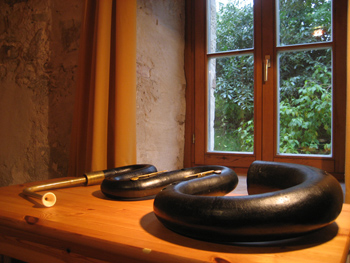 The Symposium was devoted to the cornett - also called the cornetto or, in German, zink. The cornett (not to be confused with the brasswind instrument that is a cousin of the trumpet)
is one of the most beautiful sounding instruments in the world. As the serpent has often been considered part of the cornett family (although there are significant differences
between the two instruments), the serpent was grandfathered into the Symposium. This was a happy decision for serpent players and it is what allowed me to take part in the
Symposium in some particular ways.
The Symposium was devoted to the cornett - also called the cornetto or, in German, zink. The cornett (not to be confused with the brasswind instrument that is a cousin of the trumpet)
is one of the most beautiful sounding instruments in the world. As the serpent has often been considered part of the cornett family (although there are significant differences
between the two instruments), the serpent was grandfathered into the Symposium. This was a happy decision for serpent players and it is what allowed me to take part in the
Symposium in some particular ways.
After an overnight flight from Boston to Frankfurt, I took a train to Hanover where I was met and driven to Michaelstein. Stiftung Kloster Michaelstein has taken over a 12th
century monastery that houses their institute for the study of musical instruments. It is a stunning facility, with a medieval cloister (see the photo above, left), a Rococco chapel (built after the monastery was
dissolved and converted into a school), and many other buildings with three foot thick walls. To be in such buildings is to be transported back to an earlier time - a time without
heat in every room, with windows that were Roman or Gothic arches, and a feeling of a different pace to life. My room was simple but well appointed (photo above, right), and I was
inspired by practicing in a room that was centuries old.
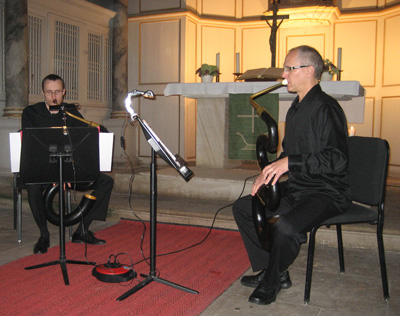 Over 40 scholars gathered for the Symposium and papers were presented on a great many topics. The serpent was well represented not only by me, but by the fine French serpent player,
Volny Hostiou.
While I had known of Volny's playing for several years, we had never met, and Symposium organizer Monika Lustig asked if the two of us would give a recital of duets
for serpent. Volny and I agreed, and when we both arrived in Michaelstein, we found we had an immediate connection that made preparing the recital great fun. The small chapel where we gave the recital was
unheated - my guess is it was about 55 degrees inside at the time we gave our recital (photo at left). Yet it was the perfect location, one that made us and all those who filled the chapel recall
a past time when heat could not be taken for granted. Our program contained music from the 16th to 20th centuries. For many who were present, it was the first time they had ever
heard the serpent and judging from the generous applause and later comments, it seemed we made a positive impression and helped to further the positive reputation of the serpent.
Over 40 scholars gathered for the Symposium and papers were presented on a great many topics. The serpent was well represented not only by me, but by the fine French serpent player,
Volny Hostiou.
While I had known of Volny's playing for several years, we had never met, and Symposium organizer Monika Lustig asked if the two of us would give a recital of duets
for serpent. Volny and I agreed, and when we both arrived in Michaelstein, we found we had an immediate connection that made preparing the recital great fun. The small chapel where we gave the recital was
unheated - my guess is it was about 55 degrees inside at the time we gave our recital (photo at left). Yet it was the perfect location, one that made us and all those who filled the chapel recall
a past time when heat could not be taken for granted. Our program contained music from the 16th to 20th centuries. For many who were present, it was the first time they had ever
heard the serpent and judging from the generous applause and later comments, it seemed we made a positive impression and helped to further the positive reputation of the serpent.
The presentation of papers by scholars was the main part of each day. For my topic, I chose a subject that has been of great interest to me, "Marches and Divertimenti: Haydn and the
Serpent." 2009 is the 200th anniversary of Joseph Haydn's death, so with this topic, I hoped to add something to both the serpent and Haydn literatures. Haydn's writing for serpent - in
three Divertimenti for winds that are attributed to him and in four marches for English military bands - is superb. I collected all of the existing manuscripts of these pieces and
prepared a Powerpoint presentation of the scores along with images of serpents, iconography from the British Museum, and audio recordings of the works I discussed that were made by
several of my Boston Symphony Orchestra colleagues who joined my playing serpent. I was very gratified by the tremendous and generous response of those present and since I have arrived
home, I have been working to put the finishing touches on what will be the print version of my paper that will be published in a book of the Symposium's proceedings sometime next year.
 There was also a fine exhibition of musical instruments that had been assembled for the Symposium, focusing on the cornett and serpent (shown at right). The serpent
in the display case is a fine example of
an early military serpent (possibly German in origin, c. early 19th century) that has some significance to my paper and my search for the earliest English military serpent. The
serpent Forveille (shown at far right in the cabinet) is a form of upright serpent that I also played and demonstrated on my upcoming serpent DVD project (for more on that, see my
sabbatical diary entry for June 10, 2009). The exhibition was a great way to bring more tangible reminders of what we were studing to
the participants. For me, music is always to be played, and bringing more instruments to us allowed all who were gathered to bring the music alive off the page.
There was also a fine exhibition of musical instruments that had been assembled for the Symposium, focusing on the cornett and serpent (shown at right). The serpent
in the display case is a fine example of
an early military serpent (possibly German in origin, c. early 19th century) that has some significance to my paper and my search for the earliest English military serpent. The
serpent Forveille (shown at far right in the cabinet) is a form of upright serpent that I also played and demonstrated on my upcoming serpent DVD project (for more on that, see my
sabbatical diary entry for June 10, 2009). The exhibition was a great way to bring more tangible reminders of what we were studing to
the participants. For me, music is always to be played, and bringing more instruments to us allowed all who were gathered to bring the music alive off the page.
In addition, there was a vigorous "round table" discussion on the subject of the bass cornett, an instrument that scholars are certain existed but whose use is really not
completely known. As I had played one of three bass cornetts that have been made in modern times (once again, see my
sabbatical diary entry for June 10, 2009 for a photo of me with a bass cornett), I was asked to take part in the discussion. It was fascinating
to say the least.
I left Michaelstein exhilirated and energized, with many questions answered and many new trails down which to walk. My new friendship with Volny Hostiou will, I am confident, lead
to future collaborations. Already an International event devoted to the serpent is being planned for Paris in 2011 - I will be there, for sure. As I continue to explore early music,
I find the lens through which I view my trombone playing with the Boston Symphony changing in ways big and small. Next week, the Boston Symphony will be playing Beethoven's great
Symphony 9 and in those performances, I will be playing a German bass trombone made in the 1920s by Kruspe. Playing these old trombones - which represent the zenith of
German trombone making - adds a different kind of sound to our trombone section and to the BSO. It is a sound that has captivated every conductor who has heard them. I feel
very fortunate to be in a trombone section that appreciates the value of the old as we push forward into the future. My experience in Michaelstein is just another in my musical
journey that has given me much to consider and which is leading me into new ways of thinking and performing.
-
August 28, 2009 - NEW
I have added photos of Daniel Chester French's stunning sculpture, "The St. Paul's School War Memorial" ("Death and Youth"), to my resource,
Daniel Chester French: Sculpture in Situ.
-
August 17, 2009 - COMMENTARY
 Today my friend, Rev. Michael Alliegro, passed from this world to the next.
Today my friend, Rev. Michael Alliegro, passed from this world to the next.
In 1979, I interviewed for the position of Director of Bands at St. Thomas Aquinas High School in Edison, New Jersey. The advertisement in The New York
Times said to reply to "Father Alliegro." Misreading the name, I assumed that "Father Allegro" was a code name for the music position at the school. It wasn't
until I arrived for my interview that I realized that Father Alliegro was not only truly a person, but he was a person who would have a significant impact on my life.
I was hired for the position at STA (now Bishop Ahr High School) and knew I had work to do. I am certain there were better qualified candidates than I that were
passed over. But there was something about how Father Alliegro and I interacted that was more than that of employer and employee. Eight years my senior, he was
still a young man at the time, and he had his hands full administering a high school. My hands were full, too, leading the concert band, marching band and
beginner band, teaching music theory and a class titled, "Bach to Rock," conducting the school musicals and scoring half time shows. The pay was low and the
work was hard, but with the support of of "Father Mike", I pushed forward and did my best.
Michael Alliegro was a kind man who was intelligent and wise beyond his years. His confidence in me bouyed me and helped me shepherd my students to be not
only better players but better people as well.
The highlight of my two year tenure at St. Thomas Aquinas High School came early in my tenure, when our band was selected to perform at Pope John Paul II's
visit to Battery Park, New York in October 1979. I wrote about this in my "What's New?" entry for April 2, 2005, below. It was a big moment for our school
and its students, and Father Mike and I often talked about the special significance of the event for all of us.
I left STA in June 1981 after the school's annual graduation ceremony was over. I had won the position of bass trombonist in the Baltimore Symphony and I was
leaving for Baltimore the next day. After graduation, I cleaned up (I am convinced that half the life of a high school band director is spent "cleaning up"),
locked up the band room and went to the main office to turn in my not inconsiderable ring of school keys. I saw Father Mike at the end of the hallway and
after getting his attention, I sent my keys down the hall as if they were a bowling ball. They came to rest at Father Mike's feet. "God bless you, friend," he said.
And I was on my way.
We kept in touch from time to time, and several years ago I learned he was dealing with cancer. Last October, my wife and I had dinner with him and Dr. Glenn
Fortin, one of my former students at STA all those years ago (Glenn was a flute player and is now a pediatrician) in New York City, before a Boston Symphony
Concert in Carnegie Hall. Our dinner was a very special time, and I took the opportunity to thank Father Mike for his confidence in me, for his giving me a
chance at my first full time music job. He was gracious but I could tell that he was very happy for and proud of me. A piece of him went with me from STA on to
Baltimore and then to Boston. It was the last time I saw him.
Later this week I will drive to his funeral at the Cathedral of St. Francis of Assisi in Metuchen, New Jersey. Rev. Monsignor Michael J. Alliegro will be laid
to rest. I am a better person for having known this Godly man and man of God. Requiem aeternam dona ei, Domine.
-
August 5, 2009 - NEW
 I began working with the YAMAHA Corporation on the development of a new bass trombone in 1986. By 1992, our collaboration had gotten to the point where the YBL-622
bass trombone was released, and in 2007, the instrument was relaunched - with significant improvements - as the YBL-822G. My relationship with Yamaha has been
a very fruitful one, and also has included the development and marketing of the Douglas Yeo Signature Series Bass Trombone Mouthpiece.
I began working with the YAMAHA Corporation on the development of a new bass trombone in 1986. By 1992, our collaboration had gotten to the point where the YBL-622
bass trombone was released, and in 2007, the instrument was relaunched - with significant improvements - as the YBL-822G. My relationship with Yamaha has been
a very fruitful one, and also has included the development and marketing of the Douglas Yeo Signature Series Bass Trombone Mouthpiece.
Several months ago, I was asked to help in the development of the trombone area of a new Yamaha website titled,
MEET THE BAND.
This site is designed for beginners to learn more about the instruments of the band, to get some information about the instruments, view a short instructional
video, and get advice from notable professional players. I was very pleased to be asked to help put together the trombone area of
MEET THE BAND
and today, the trombone section of the website was launched. I hope you will enjoy this new resource and that you will pass it on to others who might find it to be
helpful. Click
HERE
to go to
MEET THE BAND.
Once there, click on the musical note icon above the word "trombone" and you'll be on your way.
-
July 20, 2009 - COMMENTARY
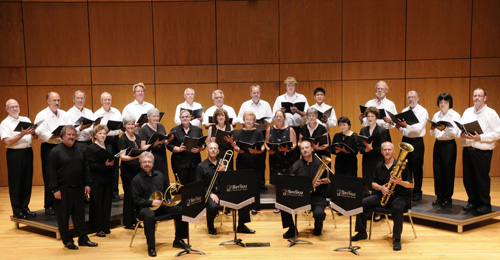 This past weekend, I attended the 25th annual Early Brass Festival, hosted by the
Historic Brass Society.
Held on the campus of Connecticut College in
New London, Connecticut, the EBF is held at the middle weekend of the two week long annual Amherst Early Music Festival. These gatherings bring together players on a
host of early instruments and are always informative, convivial gatherings of like-minded people who share an interest in early music.
This past weekend, I attended the 25th annual Early Brass Festival, hosted by the
Historic Brass Society.
Held on the campus of Connecticut College in
New London, Connecticut, the EBF is held at the middle weekend of the two week long annual Amherst Early Music Festival. These gatherings bring together players on a
host of early instruments and are always informative, convivial gatherings of like-minded people who share an interest in early music.
Readers of my website know of my long time love of early bass brass instruments - in particular the serpent and ophicleide - and the Early Brass Festival
afforded me an opportunity to engage in performance on both of those instruments.
Several years ago, my good friend, Craig Kridel, founded
Berlioz Historical Brass,
a collective of players who share a love for early brasses. Through BHB,
we have engaged in a number of performances and scholarly explorations as we continue to work to understand the sound and role of these instruments.
At this year's Early Brass Festival, I took part in two events. The first was a lecture/demonstration on the bass cornetto. This instrument is a curiosity in
the early brass family and there has been virtually no significant research into its shape, size and sound. Craig commissioned a modern reproduction of a
bass cornetto from the maker Roland Wilson (a photo may be seen on my
sabbatical diary
entry for June 10, 2009). Craig and I demonstrated both the serpent and the bass cornetto, and then engaged in a discussion of what the sound of the bass cornetto
might have been liked by using a variety of mouthpieces on the instrument. The purpose of this presentation was to, in a sense, toss a match into the discussion
about this instrument and see what might come of it. Already there is new discussion about the bass cornetto and we look forward to continued explorations.
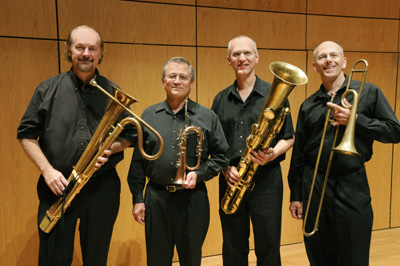 The main event of the weekend was the presentation of a concert by Berlioz Historical Brass. This concert had three parts. In Part 1, Ralph Dudgeon (keyed
bugle), Jeffrey Snedeker (natural horn), David Loucky (19th century trombone) and I (ophicleide) performed a fanfare that was written for the Historic Brass
Society by British composer Simon Proctor. It was a treat to work closely with these friends, and David Loucky and I enjoyed particular conversation about
the ophicleide. David is a fine ophicleide player; you can hear samples of his playing on
his website. The photo at left shows Craig Kridel (English bass horn),
Ralph Dudgeon (keyed bugle), myself (ophicleide) and David Loucky (19th century trombone).
The main event of the weekend was the presentation of a concert by Berlioz Historical Brass. This concert had three parts. In Part 1, Ralph Dudgeon (keyed
bugle), Jeffrey Snedeker (natural horn), David Loucky (19th century trombone) and I (ophicleide) performed a fanfare that was written for the Historic Brass
Society by British composer Simon Proctor. It was a treat to work closely with these friends, and David Loucky and I enjoyed particular conversation about
the ophicleide. David is a fine ophicleide player; you can hear samples of his playing on
his website. The photo at left shows Craig Kridel (English bass horn),
Ralph Dudgeon (keyed bugle), myself (ophicleide) and David Loucky (19th century trombone).
After the fanfare, the concert turned its attention to the premiere of a new work by the English composer, Clifford Bevan. Mendelssohn's Seasons was
commissioned by Berlioz Historical Brass and was written for natural horn, trombone, English bass horn and ophicleide with choir. Conceived as a tribute to the
great composer Felix Mendelssohn, the piece utilized four brass instruments that Mendelssohn used in his works. The conductor was Wim Becu, the noted Belgian
bass sackbut player, and the choir was the Anglican Singers of New London. The photo above, at left, shows the forces assembled before the performance.
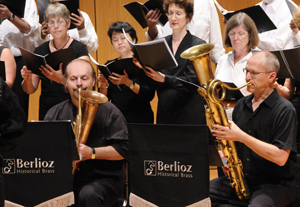 Performing this work was a joy. Clifford Bevan is a friend, and I have recorded two of his previous compositions, Les Mots de Berlioz and
Variations on "The Pesky Sarpent" on my compact disc of music for
serpent,
Le Monde du Serpent. A member of the
London Serpent Trio, he is also the author of the definitive book on
the history of the tuba and the bass brasses that preceeded it - including serpent and ophicleide - The Tuba Family. The choir was excellent and Wim Becu brought out the very
best in all of the participants.
Performing this work was a joy. Clifford Bevan is a friend, and I have recorded two of his previous compositions, Les Mots de Berlioz and
Variations on "The Pesky Sarpent" on my compact disc of music for
serpent,
Le Monde du Serpent. A member of the
London Serpent Trio, he is also the author of the definitive book on
the history of the tuba and the bass brasses that preceeded it - including serpent and ophicleide - The Tuba Family. The choir was excellent and Wim Becu brought out the very
best in all of the participants.
Craig Kridel played the English bass horn (pictured at left, along side me, playing ophicleide), a short-lived form of upright serpent that Mendelssohn
used in a number of his works including A Midsummer Night's Dream. This concert was a rare opportunity for people to hear the sound of the English bass horn as
it is exceedingly rare to see one in performance; in fact, Craig is the world's leading exponent of this fascinating instrument.
The final part of my involvement in the concert was giving the world premiere of Therese Brenet's De bronze et lumiere, a solo for serpent and piano. This
was a special opportunity to bring the serpent squarely into the 21st century. My accompanist, John Anthony, and I were delighted with the strong response of the
audience that enthusiastically greeted our performance. Therese Brenet is perhaps the most well known composer to write for the serpent since Hector Berlioz, and
giving the premiere of this new work was a very satisfying way to conclude my involvement at the 2009 Early Brass Festival.
July 1, 2009 - NEW
Today I officially completed a six-month sabbatical from the Boston Symphony Orchestra. This was a remarkably rich time for me, during which I logged over 40,000
air miles, travelling around the world to engage in trombone recitals and teaching, early music performances, guest conducting and much more. During this time
I kept a diary of my activities which I updated every few days; today I posted the final update. Click
HERE
to visit my
SABBATICAL DIARY.
-
May 14, 2009 - COMMENTARY
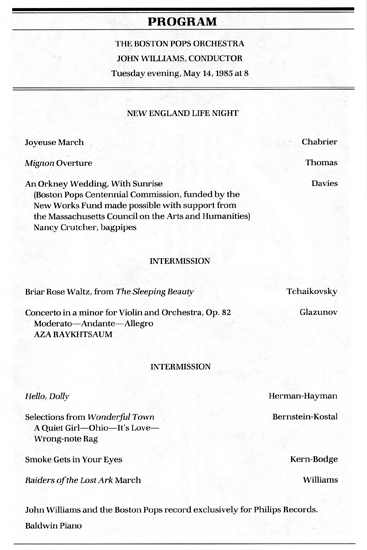 Today I celebrated another milestone of my career. 24 years ago today, I played my first concert as a member of the Boston Symphony Orchestra.
Today I celebrated another milestone of my career. 24 years ago today, I played my first concert as a member of the Boston Symphony Orchestra.
I auditioned for the Boston Symphony twice. While I was the winner of the first audition I took in 1984, then Music Director Seiji Ozawa decided not to hire anyone at that time.
Instead, I was asked to play with the BSO at its summer festival home, Tanglewood, for two weeks, travel with the orchestra on a European tour for several weeks,
and return to Boston to record Strauss' Don Quixote with Yo-Yo Ma as cello soloist. That was a great, memorable time for me, and I got a taste of what
my musical life might be like if God led my life in such a way that I might win the next BSO audition. Win it I did, in December, 1984, and on May 14, 1985, I
officially joined the Boston Symphony and played my first concert as a member.
On the night before my first BSO concert I played a concert in Carnegie Hall with the Baltimore Symphony Orchestra, my last with that fine orchestra with which
I played for four years.
The concert in Carnegie Hall had several Boston connections. The violin soloist in the Dvorak Violin Concerto was Joseph Silverstein, the Baltmore
Symphony's Principal Guest Conductor and then concertmaster of the Boston Symphony. Joe Silverstein was the person who told me that Boston would be having a
bass trombone opening and he was always very kind and encouraging to me. The final piece on the concert was Bartok's Concerto for Orchestra which received
its world premiere by the BSO in 1944. After the concert, I drove to Boston and the next day began my career with the BSO.
In May, the BSO puts on its "other hat" and turns into the Boston Pops Orchestra. My first service with the orchestra was a concert - no rehearsal - that was
televised for broadcast on "Evening at Pops," one of the longest running television series on our Public Television network. Norman Bolter was playing principal
trombone in the Boston Pops Orchestra, John Huling (who later went on to play second trombone with the National Symphony in Washington D.C.) was playing second
trombone and Chester Schmitz was the tubist. John Williams was on the podium. When I look at that first program I played (above) I smile and remember that feeling
I had when that first downbeat came. It was the begining of something very special.
There were no fireworks tonight, no big celebration to commemorate the beginning of my 25th season with the Boston Symphony. But when this day rolls around each
year, I spend some time thinking about that day many years ago when this important chapter of my life began. It has been a great ride and Lord willing
there is more yet to come.
-
May 5, 2009 - UPDATE
I have updated my
Bass Trombone Discography to add many
new recordings featuring bass trombone.
-
March 26, 2009 - NEW
I have added a new article, originally given as a chapel message at Northwestern College in Saint Paul, Minnesota.
Look For the Ancient Paths is a challenge to look at one's life and sense of calling through new eyes.